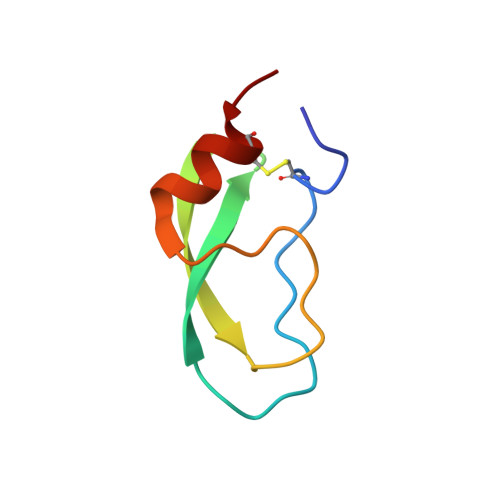Hydrophobic surface residues can stabilize a protein through improved water-protein interactions.
Islam, M.M., Kobayashi, K., Kidokoro, S.I., Kuroda, Y.(2019) FEBS J
- PubMed: 31175706
- DOI: https://doi.org/10.1111/febs.14941
- Primary Citation of Related Structures:
5XX2, 5XX3, 5XX4, 5XX5 - PubMed Abstract:
Protein stabilization is difficult to rationalize, but the detailed thermodynamic and structural analysis of a series of carefully designed mutants may provide experimental insights into the mechanisms underlying stabilization. Here, we report a systematic structural and thermodynamic analysis of bovine pancreatic trypsin inhibitor (BPTI) variants that are significantly stabilized through a single amino acid substitution at residue 38, which is located in a loop mostly exposed on the protein surface. Differential scanning calorimetry indicated that the BPTI-[5,55]Gly 14 variants with a single mutation at position 38 were stabilized in an enthalpy-driven manner and that the magnitude of the stabilization increased as the hydrophobicity of residue 38 increased. This increase in the thermal stability of BPTI was unexpected because a hydrophobic residue on a protein surface is usually destabilizing. To identify the structural determinants of this stabilization, we determined the crystal structures of six BPTI-[5,55]Gly 14 variants (Gly 14 Gly 38 , Gly 14 Ala 38 , Gly 14 Val 38 , Gly 14 Leu 38 , Gly 14 Ile 38 , and Gly 14 Lys 38 ) at high resolutions and showed that they retain essentially the same structure as the wild-type BPTI. A more detailed examination of their structures indicated that the extent of thermal stabilization correlated with both improved local packing and increased hydration around the substitution sites. In particular, the number of water molecules near residue 38 increased upon mutation to a hydrophobic residue suggesting that improved hydration contributed to the enthalpy-driven stabilization. Increasing a protein's thermal stability by the placement of a hydrophobic amino acid on the protein surface is a novel and unexpected phenomenon, and its exact nature is worth further examination, as it may provide a generic method for stabilizing proteins in an enthalpy-driven manner. DATABASE: The coordinates and structure factors of Gly 14 Gly 38 , Gly 14 Ile 38 , Gly 14 Leu 38 , and Gly 14 Lys 38 variants of BPTI-[5,55] are deposited in the Protein Data Bank under the PDB entry codes 5XX3, 5XX5, 5XX2, and 5XX4, respectively. We previously reported the structures of Gly 14 Ala 38 (2ZJX) and Gly 14 Val 38 (2ZVX).
- Department of Biochemistry and Molecular Biology, University of Chittagong, Chittagong, Bangladesh.
Organizational Affiliation:

















